Table of Contents
- Introduction
- Editor’s Choice
- Global Cell Phone Charger Market Overview
- Cell Phone Charger Specifications
- Top Cell Phone Charger Exporting Nations
- Top Cell Phone Charger Importing Nations
- Price of Wireless Cell Phone Chargers
- Key Attributes in Cell Phone Chargers Statistics
- Energy Consumption of Cell Phone Chargers Statistics
- Issues with Cell Phone Charger Statistics
- Action Taken to Resolve Problems Experienced with Mobile Phone Chargers
- Conclusion
- FAQs
Introduction
Cell Phone Charger Statistics: A cell phone charger is designed to recharge the battery of a mobile phone by converting electrical energy into a format that is compatible with the battery. There are various chargers, such as wired, wireless, solar, and portable power banks.
Wired chargers use cables to connect to power sources, while wireless chargers transmit energy without wires. Portable power banks store electricity for charging on the go. Chargers typically include adapters, cables, connectors, and circuitry to control voltage and current.
Choosing a charger that matches your device and considering factors like charging speed, portability, and safety features is essential.
Chargers should also include safety measures to protect devices from damage. Understanding these basics helps users select the correct chargers for effective and safe charging.
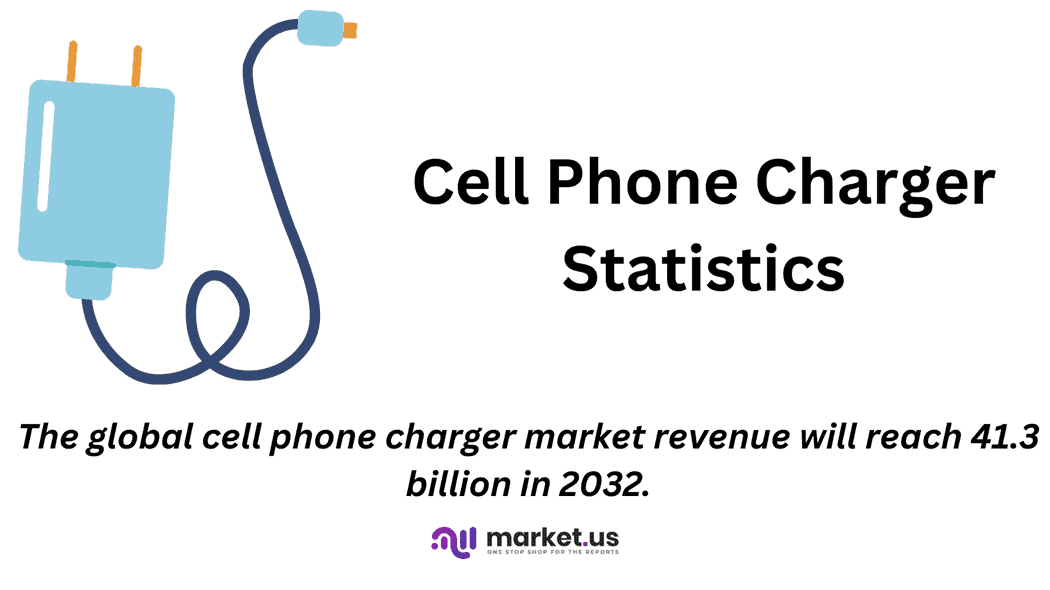
Editor’s Choice
- The global cell phone charger market revenue reached 18.5 billion in 2023.
- By 2032, the total market revenue is projected to reach USD 41.3 billion, with wired chargers generating USD 21.3 billion and wireless chargers contributing USD 20.0 billion.
- In cell phone charging solutions, two primary applications dominate the market share. General chargers, encompassing wired and wireless variants, hold the lion’s share at 52%.
- China is the undisputed leader in cell phone charger exports, with shipments totaling a staggering 256,765 thousand units.
- In the global landscape of cell phone charger imports, India emerges as the foremost destination, with an influx of 205,603 thousand units.
- In the global market for wireless phone chargers in 2023, Belkin BoostCharge Pro 3-in-1 commanded a price of $139.95.
- When considering critical attributes in cell phone chargers, charging time emerged as the most significant factor, with 16% of respondents highlighting its importance.
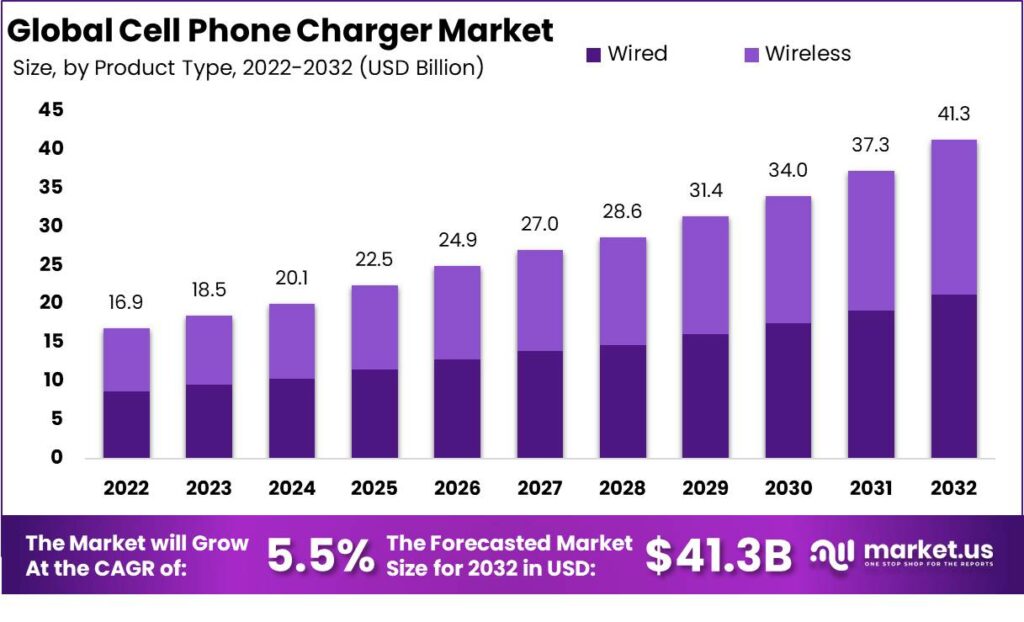
Global Cell Phone Charger Market Overview
Global Cell Phone Charger Market Size Statistics
- The global market revenue for cell phone chargers has consistently increased at a CAGR of 5.5%.
- Starting at USD 16.9 billion in 2022, the revenue increased to USD 18.5 billion in 2023, followed by further growth to USD 20.1 billion in 2024.
- This positive trajectory continued, with revenues reaching USD 22.5 billion in 2025 and USD 24.9 billion in 2026.
- The market is projected to expand, reaching USD 27.0 billion in 2027 and USD 28.6 billion in 2028.
- By 2029, the revenue is expected to surpass the USD 31 billion mark, reaching USD 31.4 billion and further increasing to USD 34.0 billion in 2030.
- The growth is driven by increasing smartphone penetration, technological advancements, and the demand for faster and more efficient charging solutions.
- The market is anticipated to continue its upward trajectory, with revenues forecasted to reach USD 37.3 billion in 2031 and USD 41.3 billion in 2032, reflecting sustained growth and market expansion.
(Source: Market.us)
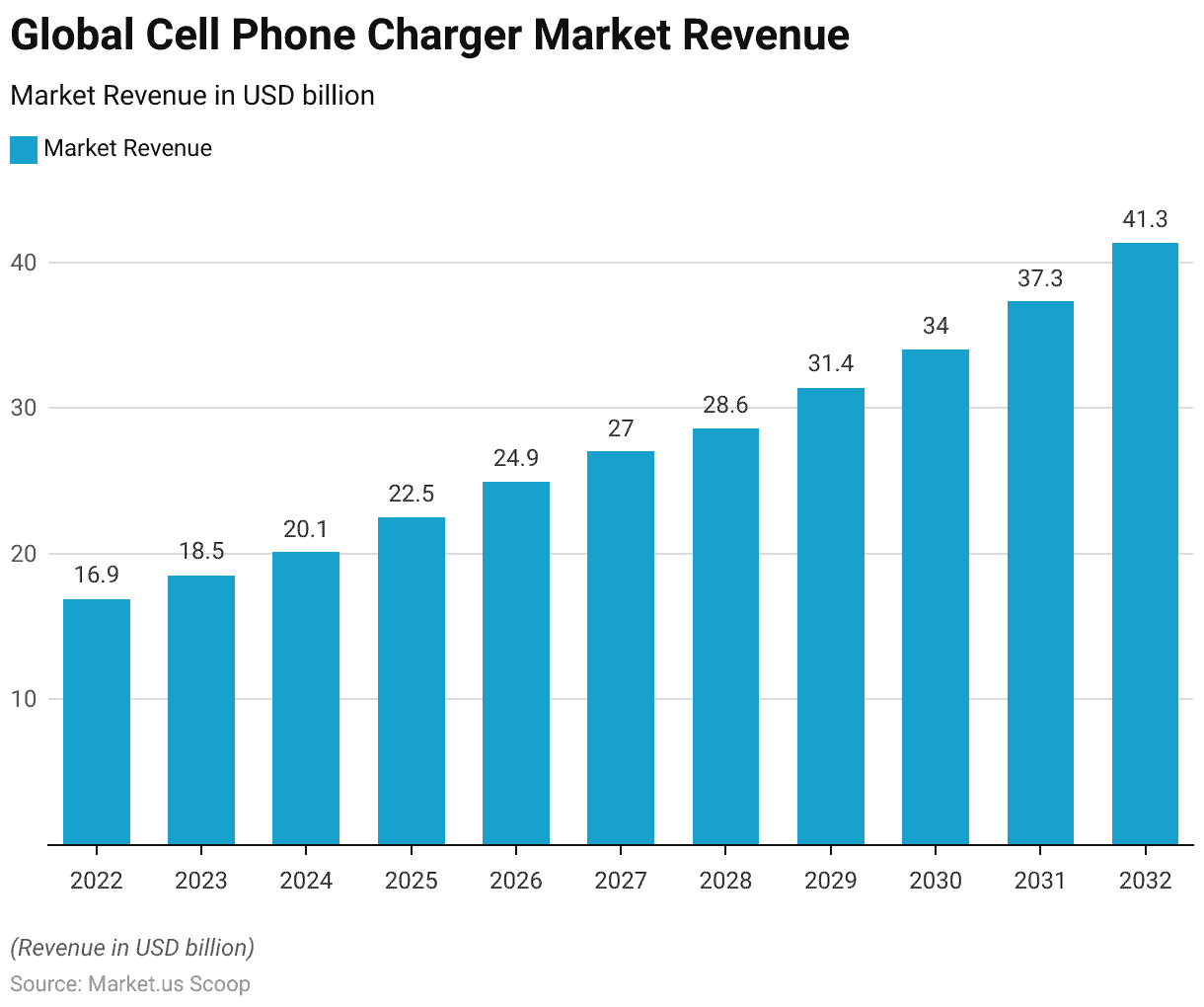
Cell Phone Charger Market Size – By Product Type Statistics
- The global cell phone charger market size, categorized by product type, illustrates a notable expansion in revenue across wired and wireless segments over the forecast period.
- In 2022, the total market revenue amounted to USD 16.9 billion, with wired chargers generating USD 8.7 billion and wireless chargers contributing USD 8.2 billion.
- This trend continued as the market progressed, with revenues increasing steadily yearly.
- By 2032, the total market revenue is projected to reach USD 41.3 billion, with wired chargers generating USD 21.3 billion and wireless chargers contributing USD 20.0 billion.
- This growth can be attributed to factors such as the proliferation of smartphones, advancements in charging technology, and the increasing demand for convenience and efficiency in charging solutions.
(Source: Market.us)

Global Cell Phone Charger Market Share – By Application Statistics
- In cell phone charging solutions, two primary applications dominate the market share. General chargers, encompassing wired and wireless variants, hold the lion’s share at 52%.
- These chargers serve as the standard means of replenishing battery power for mobile devices, offering versatility and compatibility with various phone models.
- On the other hand, power banks secure a significant 48% of the market share. These portable battery packs provide users with on-the-go charging capabilities, catering to the increasingly mobile lifestyle of consumers.
- The substantial market presence of general chargers and power banks highlights consumers’ diverse needs and preferences in the cell phone charging landscape.
(Source: Market.us)
Take advantage of our unbeatable offer - buy now!

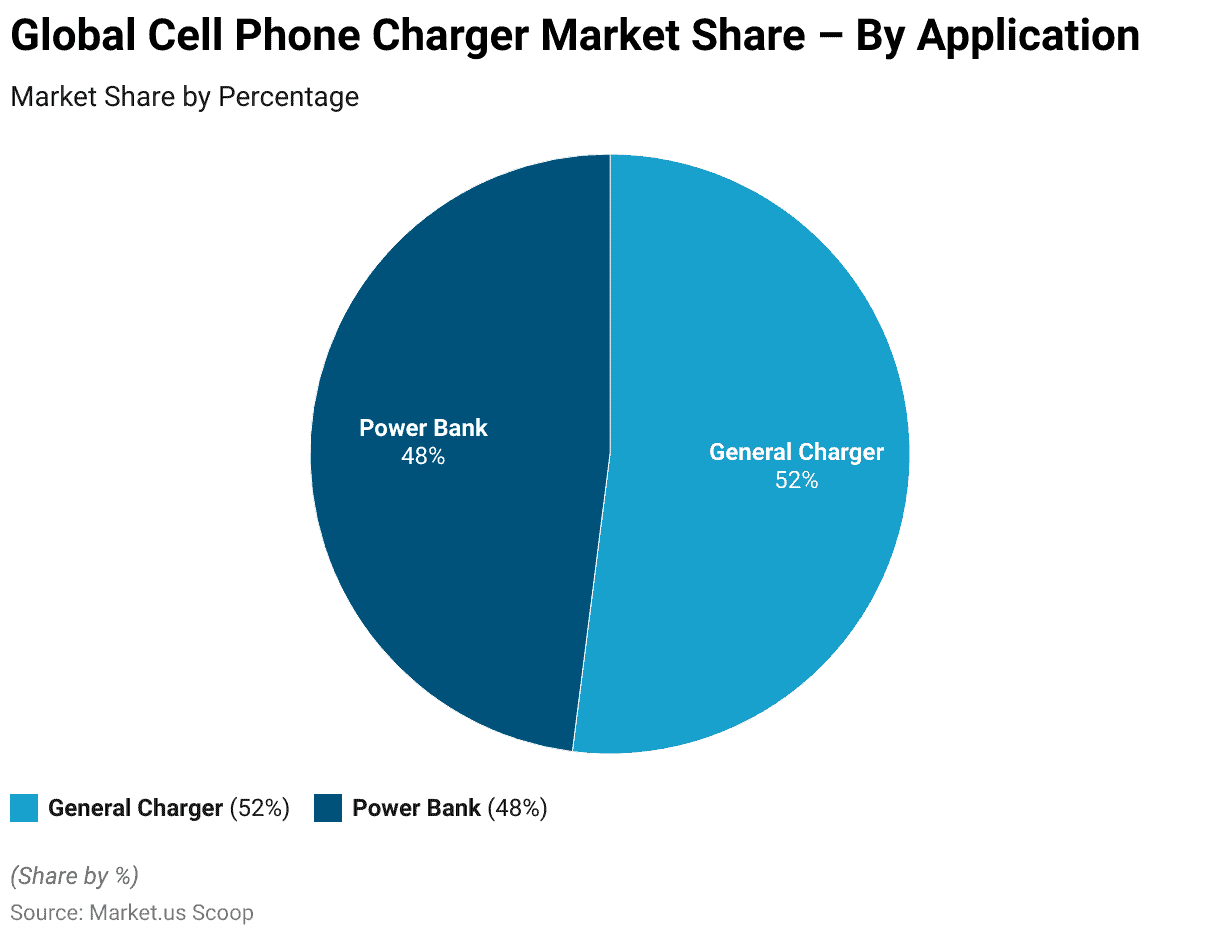
Cell Phone Charger Specifications
- Cell phone chargers come in various specifications tailored to different devices’ diverse power requirements.
- Starting at 1A with a voltage of 5V, these chargers commonly accompany most smartphones, providing sufficient power for efficient charging. USB hubs typically utilize a 1.5A charger at 5V, supporting BC1.2 standards for enhanced compatibility.
- For devices with higher power demands, such as iOS devices and many tablets like the iPad, a 2.1A charger at 5V is required.
- Some smartphones, such as the Samsung Galaxy Note II, can also utilize a 2A charger. For optimal charging of most iOS devices, a 2.4A charger at 5V is recommended, providing ample power to facilitate rapid charging.
- These varying specifications cater to the specific needs of different devices, ensuring efficient and safe charging experiences for users across a range of electronic gadgets.
(Source: Cambrionix)
Top Cell Phone Charger Exporting Nations
- China is the undisputed leader in cell phone charger exports, with shipments totaling a staggering 256,765 thousand units.
- Following closely behind is Vietnam, with a robust export figure of 199,294 thousand units.
- South Korea and Hong Kong also contribute significantly to the global market, with shipments of 7,372 thousand and 4,777 thousand units, respectively.
- India and Taiwan demonstrate noteworthy involvement in the industry, exporting 1,981 thousand and 1,400 thousand units, respectively.
- Meanwhile, Malaysia and the UAE exhibit moderate participation, with exports amounting to 941 thousand and 560 thousand units, respectively.
- Although comparatively more minor players, Finland and Namibia still contribute to the global market, with shipments of 326 thousand and 273 thousand units, respectively.
- This data underscores the dominance of East Asian nations in the cell phone charger export landscape, driven by their robust manufacturing capabilities and strategic market positioning.
(Source: Volza)
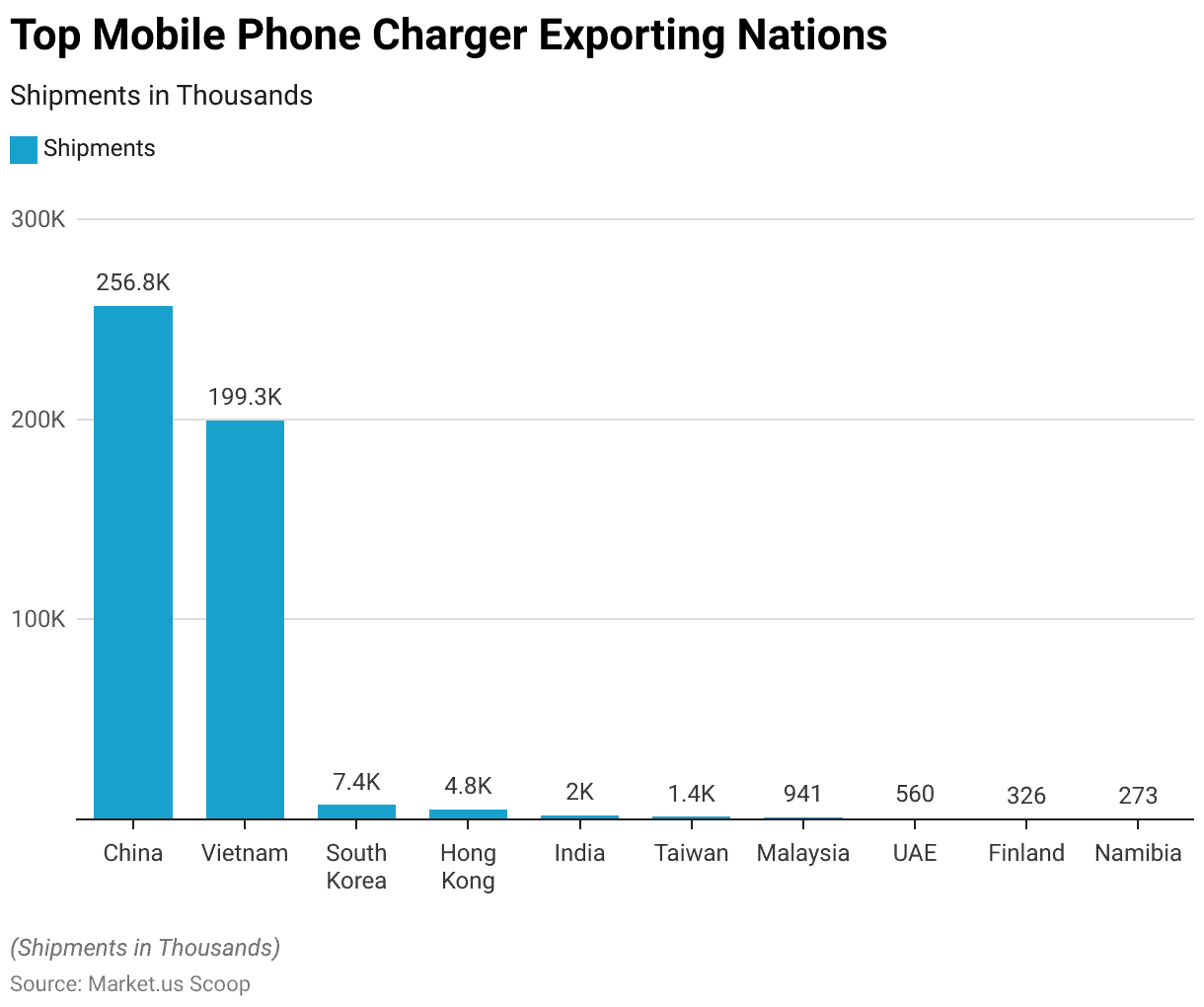
Top Cell Phone Charger Importing Nations
- In the global landscape of cell phone charger imports, India emerges as the foremost destination, with an influx of 205,603 thousand units.
- Following India, Vietnam demonstrates significant demand, importing 122,166 thousand mobile phone chargers.
- South Korea and Hong Kong also feature prominently as importing nations, with shipments of 47,394 thousand and 18,240 thousand units.
- The United States, despite its technological prowess, imports 17,731 thousand units, highlighting its reliance on international markets for cell phone charger supply.
- China, typically a dominant force in manufacturing, imports a modest 8,527 thousand units.
- The UAE, Netherlands, Singapore, and Brazil exhibit substantial import activity, with shipments ranging from 7,043 thousand to 4,493 thousand units.
- This data underscores the global demand for cell phone chargers and the diverse distribution of import activities across nations with varying economic profiles and technological capabilities.
(Source: Volza)
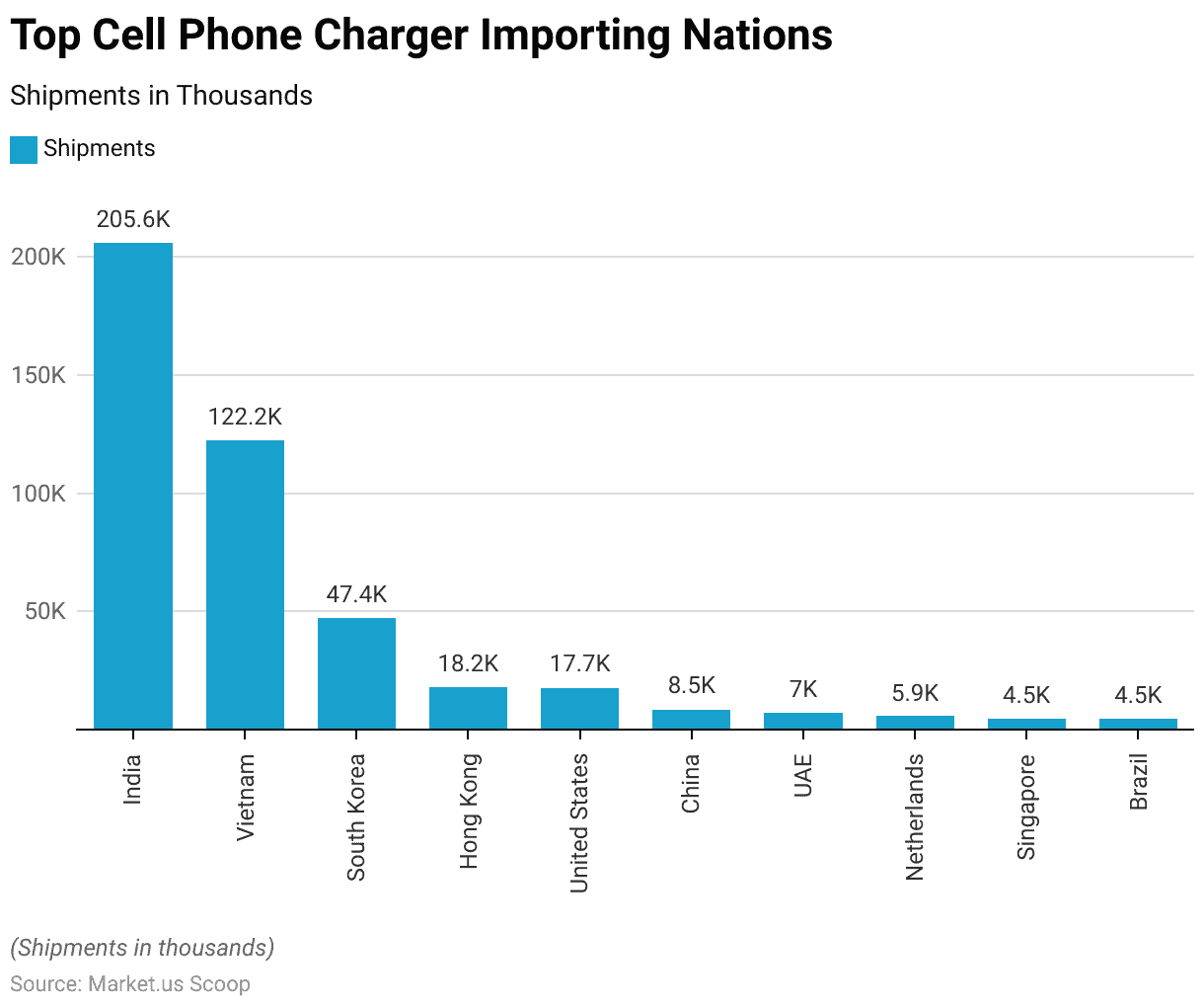
Price of Wireless Cell Phone Chargers
- In the global market for wireless chargers in 2023, retail prices varied across a range of products, reflecting diverse features and capabilities.
- At the higher end of the spectrum, premium offerings such as the Belkin BoostCharge Pro 3-in-1 commanded a price of $139.95, followed closely by the Samsung 15W Fast Charge Wireless Charging Stand at $125 and the Scosche Baselynx Modular Charging System Pro Kit at $120.
- The Zens 4-in-1 Wireless Charger also represented a significant investment at $100.
- Moving towards more affordable options, the Logitech Powered Pad and Tylt Bowl were priced at $50 each, offering a balance between functionality and cost.
- Further down the pricing scale, the Moshi Otto Q and the Belkin BoostCharge 15W were available at $39 and $36, respectively, providing a budget-friendly alternative without compromising quality.
- Towards the lower end of the price spectrum, offerings such as the Apple MagSafe Charger and the Anker PowerWave 3-in-1 were priced at $33 and $17, respectively, catering to cost-conscious consumers seeking reliable charging solutions.
- The Anker 313 Magnetic Wireless Charger Pad with USB-C Charger represented the most economical option at $16, offering affordability without sacrificing essential features.
- This range of prices reflects consumers’ diverse preferences and priorities when selecting wireless phone chargers, with options available to suit various budgets and needs.
(Source: Statista)
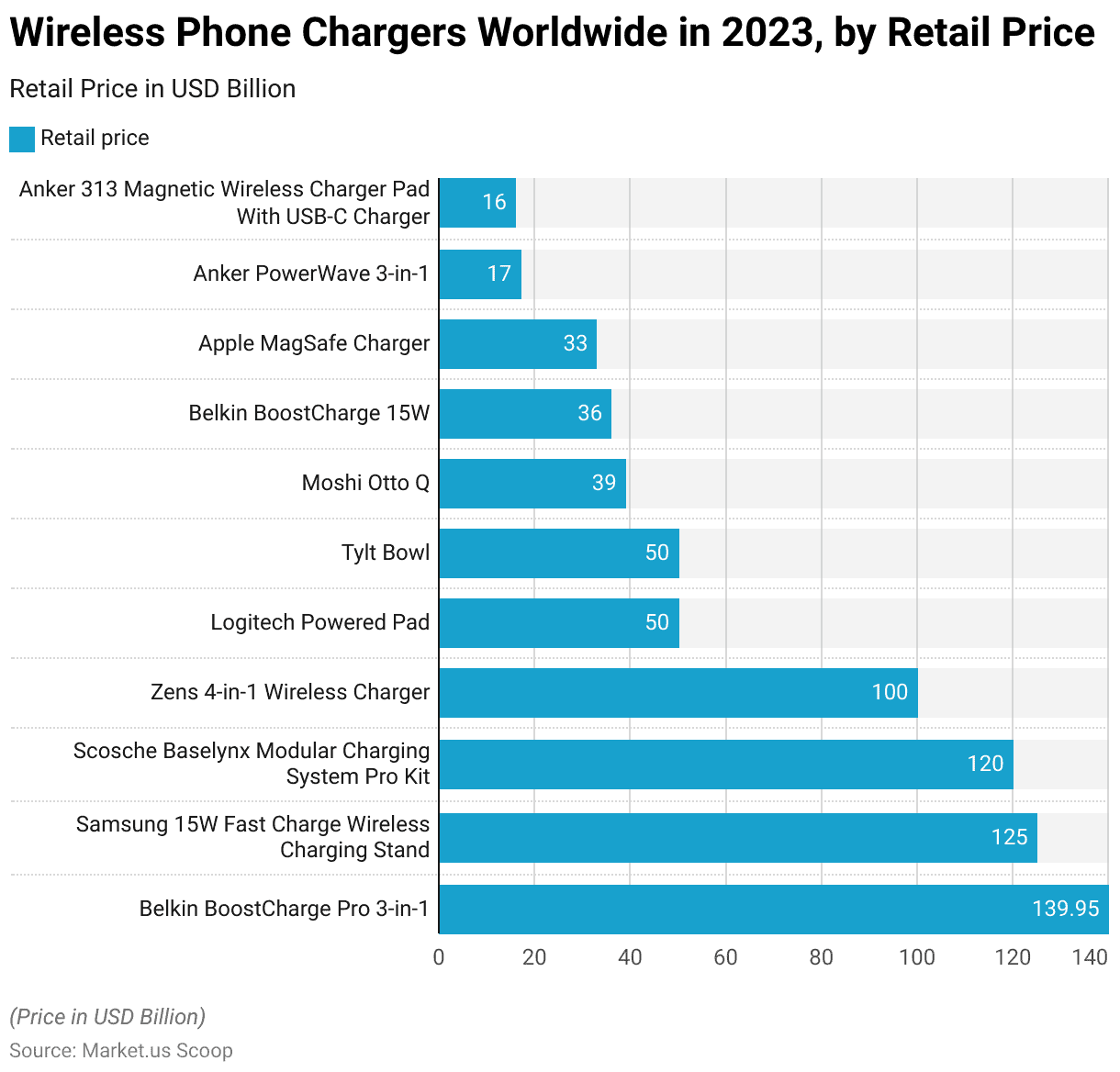
Key Attributes in Cell Phone Chargers Statistics
- Respondents indicated diverse priorities when considering key attributes in cell phone chargers.
- Charging time emerged as the most significant factor, with 16% of respondents highlighting its importance.
- The type of phone charger connector followed closely behind, garnering a notable response rate of 26%.
- Price was also a significant consideration, with 32% of respondents emphasizing its significance in their decision-making process.
- Brand recognition played a role for 11% of respondents, indicating a preference for trusted and reputable manufacturers.
- Interoperability with devices other than mobile phones was deemed necessary by 10% of respondents, suggesting a desire for versatility and compatibility across various electronic devices.
- Interoperability with other mobile phones received a lower response rate of 6%, indicating that while still relevant, it may be perceived as less critical than other attributes.
- These findings underscore the multifaceted nature of consumer preferences when selecting cell phone chargers, with factors such as charging efficiency, compatibility, affordability, and brand reputation all influencing purchasing decisions.
(Source: Politico)
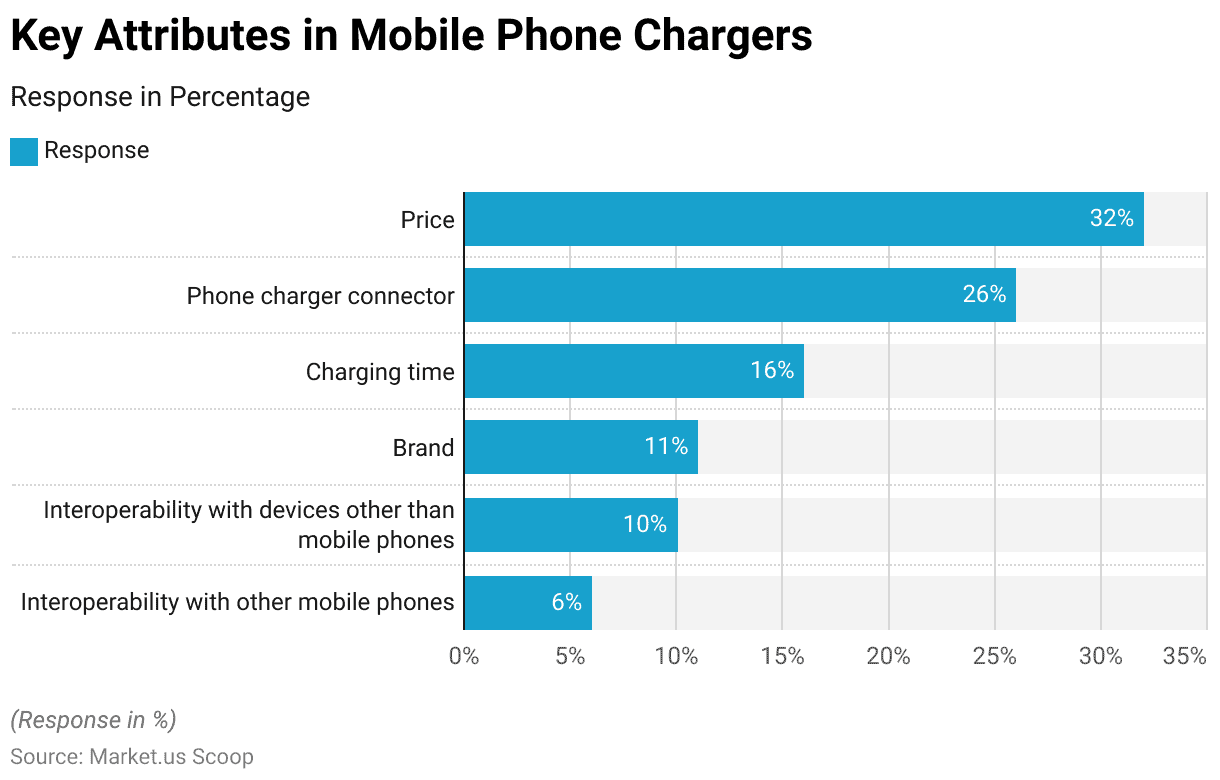
Energy Consumption of Cell Phone Chargers Statistics
- Different phone chargers consume varying amounts of electricity annually based on their wattage and running duration.
- A 5-watt charger, running for 365 hours in a year, consumes approximately 1.83 kilowatt-hours (kWh) of electricity.
- Doubling the wattage to 10 watts results in an annual consumption of 3.65 kWh, while a 15-watt charger consumes 5.48 kWh per year.
- Increasing the wattage to 20 watts leads to an annual electricity consumption of 7.30 kWh.
- These figures highlight the escalating energy usage associated with higher-wattage chargers, emphasizing the importance of energy-efficient charging practices and adopting technologies that minimize environmental impact.
(Source: Energy Sage)
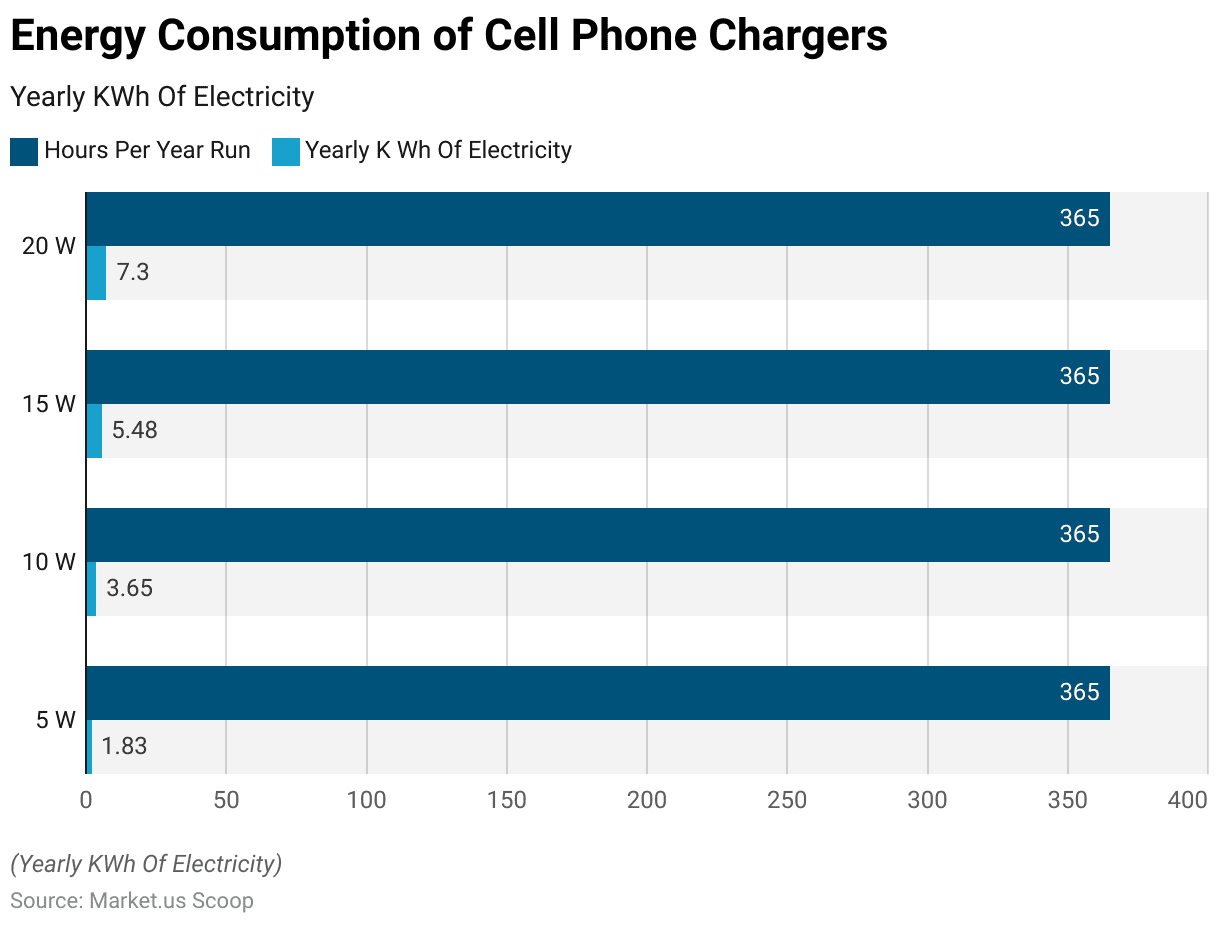
Issues with Cell Phone Charger Statistics
- A comprehensive analysis of respondents’ experiences with mobile phone chargers reveals several recurring issues.
- Notably, approximately 47% of respondents reported concerns regarding the accumulation of chargers occupying space in their homes or workplaces.
- Additionally, 47% expressed dissatisfaction with the charging speed of alternate chargers compared to their own.
- Furthermore, 51% encountered difficulties charging other electronic devices with their mobile phone charger.
- Compatibility issues were prevalent, with 62% reporting instances where available chargers were incompatible with their phones and 62% experiencing confusion regarding which charger to use for their devices.
- Safety concerns were also highlighted, with 69% encountering situations where the charger became unsafe.
- Moreover, confusion persisted regarding charger usage for mobile phones and other portable electronic devices, with 70% of respondents facing this challenge.
- Finally, while smaller percentages reported other problems, they still contributed to the overall landscape of charger-related issues.
- These findings underscore the need for more transparent standards, improved compatibility, and enhanced user education to mitigate common challenges associated with mobile phone chargers.
(Source: Ipsos consumer survey – 2019)
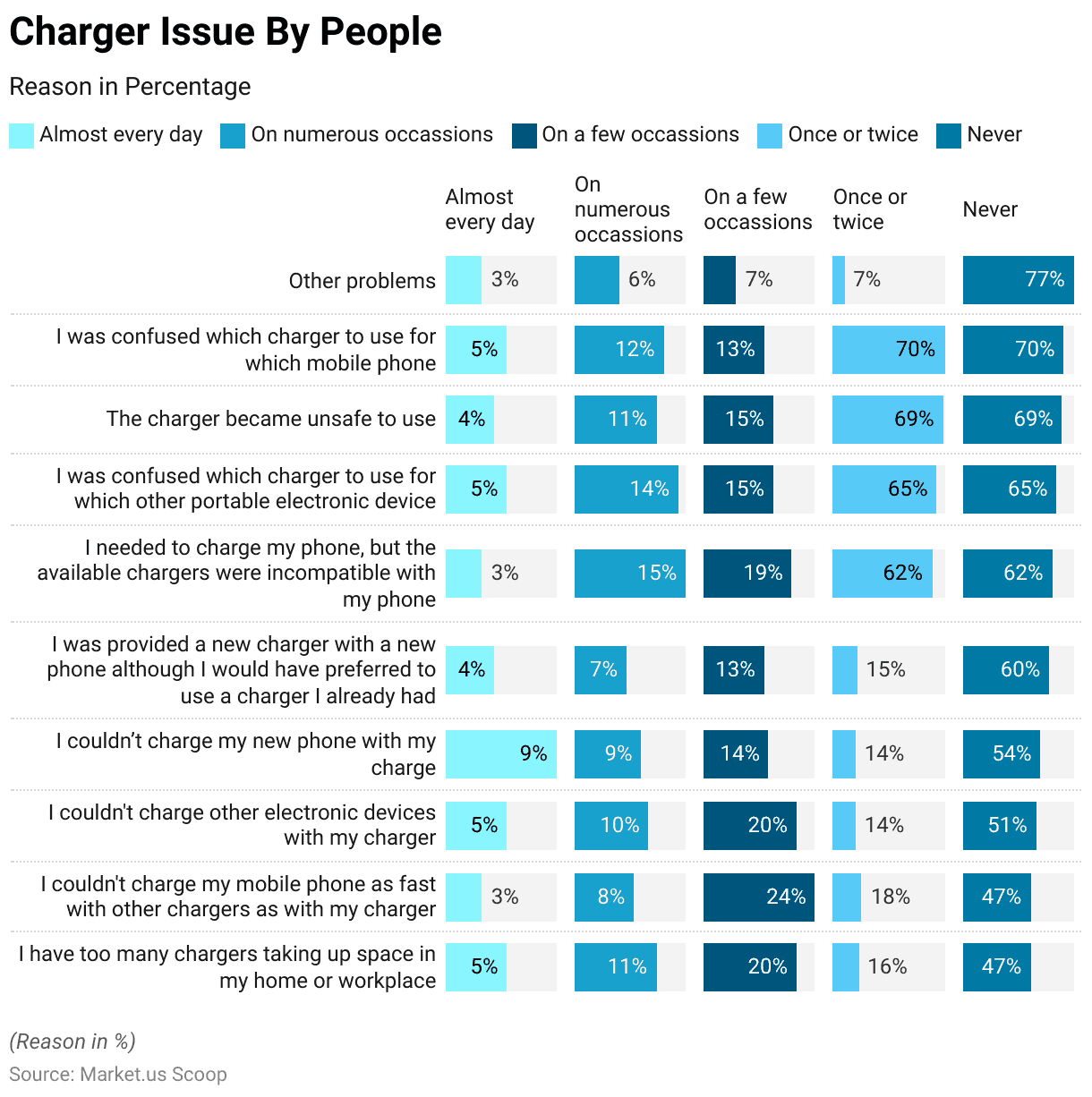
Action Taken to Resolve Problems Experienced with Mobile Phone Chargers
- Respondents took various actions in response to problems experienced with mobile phone chargers. A notable portion, accounting for 22%, opted to use one of the other chargers they possessed instead of addressing the issue directly.
- Additionally, 14% purchased an additional charger, presumably seeking a solution to their charging needs.
- A significant proportion, comprising 30%, opted to take no action, indicating a level of resignation or acceptance of the charger-related problems they encountered.
- However, some respondents did take proactive steps to resolve their issues, albeit to a lesser extent.
- This included returning the mobile phone charger to the company where it was obtained (6%), requesting a replacement from the company (6%), or seeking a refund (4%).
- A smaller percentage opted to negotiate for a price discount (3%) or lodged complaints with the company (3%), while even fewer purchased adapters (5%) or returned the charger (6%).
- A minority resorted to alternative actions, such as making complaints to entities other than the selling company (1%), expressing uncertainty (1%), or taking unspecified actions (1%).
- These responses illustrate the diverse approaches taken by individuals when faced with problems related to mobile phone chargers, reflecting varying levels of assertiveness, resourcefulness, and acceptance.
(Source: Ipsos Consumer Survey – 2019)
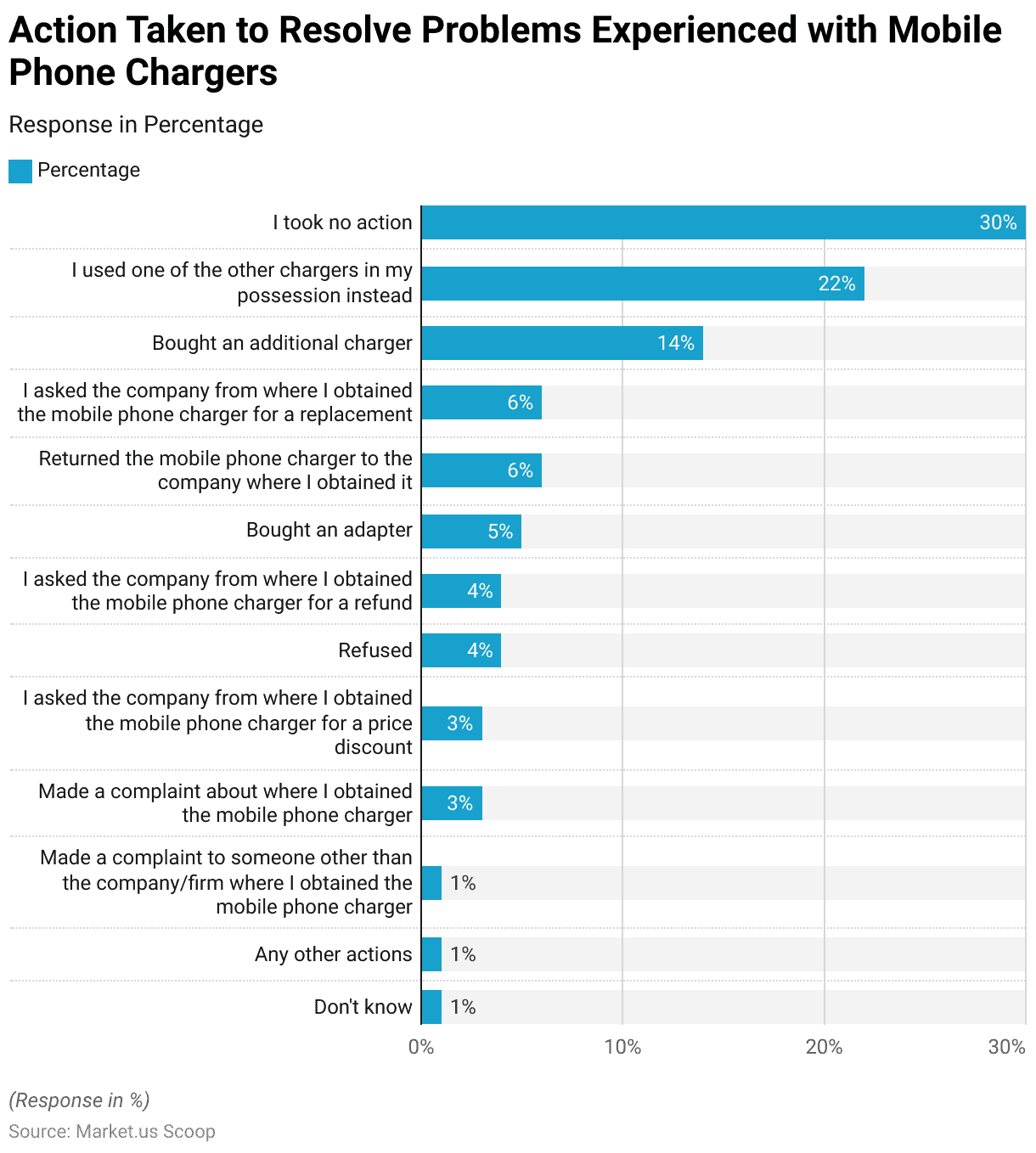
Conclusion
Cell Phone Charger Statistics – In conclusion, cell phone chargers are essential for maintaining the functionality of our mobile devices throughout the day. As technology progresses, chargers have evolved to meet the diverse needs of users, offering a wide array of specifications and features.
Whether wired or wireless, regular or fast charging, there are options to suit various preferences and device requirements. Choosing a charger that matches the device’s specifications is crucial to ensure effective and safe charging.
Furthermore, there’s a growing emphasis on sustainability and energy efficiency, prompting the development of eco-friendlier charging solutions. With the continuous rise in demand for smartphones and mobile devices worldwide, the cell phone charger market is poised for further expansion, fueled by ongoing innovation and advancements within the industry.
FAQs
There are various cell phone chargers, including wired, wireless, solar, and portable power banks.
Wired chargers require a cable connection between the charger and the phone. In contrast, wireless chargers transmit energy to the phone without cables, using electromagnetic induction.
Yes, eco-friendly charging options, such as solar chargers and chargers made from recycled materials, are available. These chargers harness renewable energy sources and help reduce environmental impact.
Newer smartphone models typically support fast charging. You can check your phone’s specifications or consult the manufacturer’s website to determine if it supports fast charging and which fast charging standards it is compatible with, such as Qualcomm Quick Charge or USB Power Delivery (PD).
Some safety tips to follow when using chargers include avoiding charging devices on flammable surfaces, unplugging chargers when not used, and keeping chargers away from water or moisture. Also, avoid using damaged or counterfeit chargers, posing safety hazards.
Discuss your needs with our analyst
Please share your requirements with more details so our analyst can check if they can solve your problem(s)



